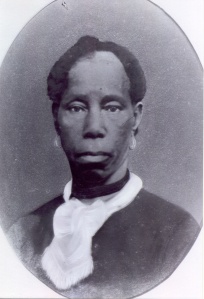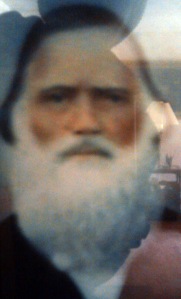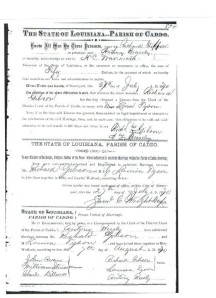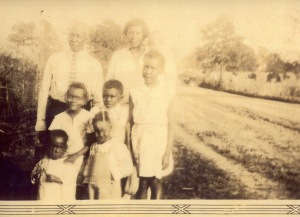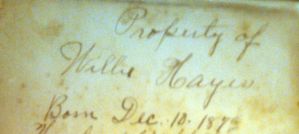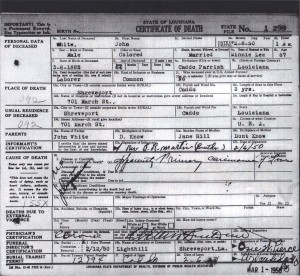Welcome to the Tyson Family Roots Blog

One photo says it all – 4 international generations; myself as a boy with my parents Ruby & Sandra Tyson, Danish grandfather Niels and my Lebanese great grand aunt Rettebeh Hashim – about 1967 Los Angeles click to view larger image
“Genealogy for Mutts” – I would buy this book, or maybe I need to write it. When you come from a international family like I do, you need all the research tips you can get.
My father Ruby Tyson, is an African American from Caddo Parish, Louisiana. His family has long deep roots in America. My mother Sandra Lee Jensen, is mixed with Danish and Lebanese. She was born and raised in Los Angeles, California. Her father was an immigrant from Denmark and her Lebanese history starts around 1890 when her grandfather came to the US from Lebanon.
We lived in a duplex while I was growing up in the 1960’s. My mother’s parents lived in the other side so I grew up with these grandparents. I am blessed to have grown up eating all this different food. Everything from southern fried catfish & buffalo, to Lebanese favorites kebbeh (national dish of Lebanon), dolmas (stuffed grape leaves), fatayer (spinach pies), and saf suf (tabbouleh), to Danish pastries. In our home you heard every kind of music I think there was. My friends all loved to eat at our house. Some information on Lebanese food here: http://en.wikipedia.org/wiki/Lebanese_cuisine.

Some classic Lebanese food

The husband of my cousin Tundra Brown; John Paul Jackson doing what he loved to do…frying up some fish. Family reunion Mira-2008
My father’s parents were Dave Tyson and Willie Lee Hayes from Mira, Louisiana. My grandfather Dave Tyson was born in 1890 in a small village in Caddo Parish, Louisiana called Frog Level (later named Rodessa). My grandmother Willie Lee Hayes was born in 1902 in Prescott, Arkansas, she grew up in Caddo Parish. My mother’s parents were Niels Peter Jensen and Edna Helen Shoucair. Grandpa Niels was born in 1897 in Hjorring, Denmark and he came to the US around 1920 and settled in Los Angeles. Grandma Edna was born in Seattle in 1906, her parents were recent immigrants from Choueifat, Lebanon.
For African American genealogy, if your family was here during slavery times you will usually hit that 1870 brick wall where records get hard to find. Before the Civil War blacks/slaves were not enumerated in the census unless they were free and if you lived to 100 years old. So we all hit this era where research becomes a challenge. Some are blessed to find valuable information in slave owner estate records that name their ancestors and some can find a trail back to the slave ship that brought their ancestor here. Depending on where your family was from you will sometimes have different family history with slavery. My family is from Louisiana which is well known for its history during and after slavery times.
For Danish genealogy there are a few websites that have parish records translated into English. One site being familysearch.org which has birth/marriage/death records available for many areas in Denmark. Another site to search Danish Parish census records going back to 1787 is;
http://www.ddd.dda.dk/kiplink_en.htm
The Danish census gave occupations and status in the community. They were listed as farm tenants, peasant farmers, land owners, etc. I had the help of a Danish genealogist Lissa Pederson via the Danish Genealogy Forum. She was able to help me confirm records that I had and go further in my line. I have my grandfather’s birth certificate so I knew who his parents were and exactly where he was born. From that information Lissa was able to give me the next generation in the family tree. Lissa also translated a few letters we had. One letter was from my great grandfather Lar’s that showed he was still alive in the 1940’s. Only one of my grandfather’s six siblings came to America, a brother William that died in Elgin, Oregon. We never met William and he had no known children. I have yet to make contact with any of this side of the family, neither from my website or ancestry.com. So this whole side of the family is unknown.
Lebanese genealogy is very difficult. There are no known databases from Lebanon at all for family records. The main records available to us from afar are records they left once they emigrated to their new homes. So you have ship manifests found at Ellis Island or similar sites, immigration records, and naturalization records that are many times the first records filed. They would file a “Declaration of Intent” which many times listed what ship they came on and some family information. Military and World War I Draft Registration cards also sometimes listed birth place and family back home. Death certificates have been very helpful and sometimes their marriage certificates will list their hometown and parents. Church records and obituaries listing family history have also been very helpful. We have a lot of old family photos and only a few had information written on them so I’m still trying to figure out who all these people were.

Hashim family in Lebanon late 1890’s; 2g-grandmother Jamila standing far right, her sister Rettebeh standing far left, assumed parents Salim & Frieda Hashim sitting, and unnamed siblings
The last official Lebanese census was taken in 1932, I’ve never seen it available online. Any previous census were done under the Ottoman Empire (1831-1872) and are only available in Turkey, all in Turkish. The Syrian National Archives also have some information, if you can get access to it, and can read Arabic. Due to wars and strife in Lebanon, marriage, death, and birth records are hard to come by. Through my website I’ve connected with many Lebanese cousins that no one in the family had ever met. We are all putting our pieces together in this puzzle. As I said Lebanese Genealogy is very difficult.
To keep myself from getting dizzy with these family trees I try to focus on one line at a time, I try to. There are days when I go back and forth when something pops in my head. I’ll be looking at slave records in Louisiana then all of a sudden something on grandma Edna pops up and I’m off in the Lebanese side.
On my father’s line I have yet to crack that slavery nut with these ancestors. My grandparents already passed down their history and to this day I still couldn’t tell them anything they didn’t already know about their roots. Since I descend from a few slave owners (Noah S. Tyson & John F. Herndon) I have found information going back many generations for my Tyson and Herndon lines. There is another Mr. Haynes from Arkansas who is the father of my 2g-grandmother Morning Haynes, he’s said to be Irish but I’ve found no information on him.
I have traced my Tyson lineage to my 8g-grandparents, the immigrant John Tyson (Jan Mathiason) who was recorded in Virginia in the mid 1600’s and his wife Susannika. DNA testing puts the Tyson family origin in the British Isles. My Y-Chromosome haplogroup R1b matches other known Tyson descendants of John and Susannika Tyson in the Tyson DNA Project. This project is administered by my 3rd cousin Forest Tyson, our great grandfathers were brothers. The book – Tyson Family History: Descendants of John Tyson & Susannika by Jerry Tyson Barton, documents my Tyson line from the immigrant John Tyson to my 2g-grandfather Noah Samuel Tyson. This documentation is solid up to my 2g-grandfather Noah Tyson and we have documentation from Noah’s generation all the way to mine. The book used family Wills, estate and probate records, and local records all referenced in the book.
My Herndon line in America goes back to my 7g-grandparents, the immigrant William Herndon who is the first Herndon on record in America and his wife Catherine (Diggs). William Herndon came to Virginia from Kent, England around 1673. The Herndon family tree goes further back to my 11g-grandparents in Kent, England; Albert John Herndon 1535-1590 and his wife Martha Ann Broderick 1538-1595. One ancestor from this era Mary McGregor 1602-1657 (my 9g-grandmother) was born in Scotland and my 10g-grandmother Colita Kinsington 1555-1630 was born in Wales.
There’s many books written on this Herndon family and some historians claim that 2 of my ancestors, Mary Waller (6g-grandmother) and Catherine Diggs (7g-grandmother) are descendants of British Royalty. The royal lineage of the Diggs and Waller family in England is not disputed, but the marriages are. These marriages took place in Virginia in the late 1600’s and early 1700’s and there are no known records to confirm the last names of these wives. There’s very good circumstantial evidence to show, such as; a granddaughter was named Catherine Diggs Herndon – a naming pattern that strongly hints to a Diggs family connection. This happened with the Waller family although there was another confirmed marriage of a Herndon and a Waller. These two marriages in my direct line are unconfirmed.
One book that I have “The Metts Ancestors in America – The Direct Line” by Albert Metts goes into these marriages extensively. The book compiled many sources that all support these two marriages. This book is available from the familysearch.org library. The main book that best documents my Herndon line from Fredericksburg, VA is; The Herndon’s of the American Revolution, (Part Two): Edward Herndon of Spotsylvania Co., VA. And His Descendants, by John Goodwin Herndon, PHD. This book documents up to the parents of my 2g-grandfather John Frederick Herndon.
This Herndon line is difficult to confirm due to burned records in Fredericksburg. The book does list the assumed parents of John Frederick Herndon as John Herndon and Mary Fleetwood. John Frederick is not mentioned in the book but his brother Fleetwood and other siblings are, this was my confirmation. We are convinced that John Frederick and Fleetwood Herndon are brother’s from John Frederick’s Will where he gives $500 to his niece Louisa Connervey in Lewisville, Arkansas. Louisa was Fleetwood Herndon’s daughter, which is confirmed in marriage and local records.
My grandfather Dave “Pawpaw” Tyson was a farmer and also a musician. Pawpaw played the guitar, piano, mandolin, harp, combs, anything you put in his hands. My grandmother “Mother Willie” had about everything they needed to eat growing in her garden. They lived in Caddo Parish in a small village called Mira which is 32 miles north of Shreveport just past Hosston. Dave’s parents were Richard Tyson and Fannie Herndon, Richard was born a slave and Fannie was a free person of color. Mother Willie’s parents were Willie White Hayes and Isabel Young.
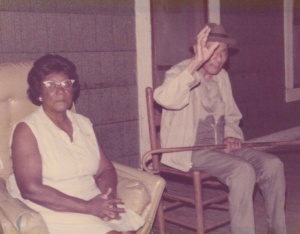
Grandparents Dave & Willie Tyson sitting on their porch in Mira, 1969
In the 1940’s the migration began from Louisiana to California. My dad’s oldest sister Myrtle was the first to come with her husband Reggie Morris in 1941. My father came to Los Angeles at 15 yrs. old in 1944 with his sister Earnestine and her husband Sesser Durden. About half the family came to Los Angeles, the rest remained in Louisiana.
The trail goes cold on my slave ancestors at my 2g-grandparents, Louisa Dunn b1830, Lou Patsy Charles b1817, Jane Hill b1845, John White b1842, Young Cage b1850; and a 3g-grandmother Netta Willis b1828. I have two previous posts on this blog on Louisa Dunn and John White. The family website for my father’s side is – http://caddotrees.com.
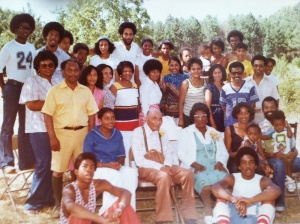
The Tyson family is very large, my father had 13 siblings, and there was 36 grandchildren of Dave & Willie Tyson – Family Reunion 1977 in Mira, Louisiana
My grandfather Niels Peter Jensen apparently stowed on a ship coming to the US around 1920. I’m unsure where he entered the US. My mom told me that he worked his way across the country doing add jobs and made his way to Los Angeles where he joined the US Marines at Mare Island, California in 1922. Something in the Viking stock, grandpa loved the Marines. He was stationed on the USS California “The Flagship of the Pacific” until 1925.
Niels married Edna Helen Shoucair in 1933 in Los Angeles. Niels parents were Lars Peter Jensen and Nielsane Johanne Peterson from Hjorring, Denmark. Lars was a blacksmith by trade. Grandpa grew up learning the trade and also painting and carpentry while working with his father Lars at a local castle. He was a perfectionist and would not finish a job until it was just right. Grandma Edna worked for her father Salim as a clerk while she was younger and later as a librarian at the Los Angeles Central Library.

My grandparents Niels & Edna Jensen with my grandmothers brothers Carl & George Shoucair, children l/r my mother Sandra, Donna, Niels Jr. Venice, CA abt. 1941
I have my Danish side confidently documented up to all my 2g-grandparents. I have gone much further on his lines, back into the 1600’s but am unsure how accurate the records are. All ancestors beyond 2g-grandparents in his tree are not confirmed. Danish naming patterns will throw you for a real loop. Prior to the mid 1800’s they didn’t use surnames. If you saw a name “Lars Pederson” it means he’s the son of Peder (Peter). My family name of Jensen means son of Jens. A female would be Jensdatter or Pedersdatter. So you have to trace families and village history and not surnames in Denmark. When a woman marries she keeps her maiden name so you can confirm people in their census; a wife of Lars Jensen would be listed as Maren Larsdatter and not Maren Jensen. Most had middle names also, without these middle names it would be really hard to match people in their records. I’m saving this for a trip to Denmark……
Lebanese people are notorious for being merchants, going back to their ancient Phoenician roots where they were the top traders of the sea. Lebanese immigration to America dates back to the mid 1850’s and communities were set up in New York and Boston. The classic dry goods store was a normal thing for many modern Lebanese immigrants. They would peddle door to door and finally set up a store front.
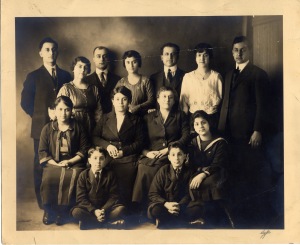
Photo from around 1921 in Raymond WA. Salim Shoucair is the elder man standing in the back, his sister Zelpha the elder woman sitting, my grandmother sitting with her brothers Carl & George. Along with Dracobly, Bardawil, Saba, and Haddad relatives
Traditional naming patterns in Lebanon give you some family history usually for three generations. For example; my great grandfather’s three names – Salim Khalil Shoucair – tell me his father’s name and his grandfather’s name. The middle name (Khalil) is his father’s first name, the last name (Shoucair) is his grandfather’s first name. Salim, son of Khalil, son of Shoucair. So I know that Salim’s father was Khalil Shoucair ? – I don’t know that 3rd name. I know Salim’s grandfather’s first name was Shoucair ??….but don’t know his middle or last name to continue with the tree. Women had the same naming patterns of carrying their father and grandfather’s names. So when you get a death certificate for an ancestor you really want to see three names. This is an example for a Christian name, the Muslim and Druze use the Arabic naming patterns. This also gives family history, an example would be; abu Da’ud (the father of David), umm Salim (the mother of Salim) or ibn ‘Umar (the son of Omar), bint ‘Abbas (the daughter of ‘Abbas).
My great grandfather Salim came to America at 17 years old in 1890 and started peddling in Seattle, Washington. In 1903 he married Jamila Hashim who had come to America in 1900. In these times many Lebanese marriages were pre-arranged and I’m unsure if their families were connected in Lebanon. Salim and Jamila were Lebanese Orthodox Christians. Many Christians in Lebanon at this time were fleeing Lebanon due to the Syrian and Ottoman Empire’s control of the area. Lebanon didn’t become an independent country until 1943. The old immigration records list them as Syrian or Turkish nationality.

The only pic of my great grandparents together; Salim & Jamila standing in the back, Jamila’s brother Hashim Salim Hashim in the middle – abt. 1911 Washington
Salim’s parents were Khalil and Nedah Shoucair, Jamila’s parents were Salim Yussif Hashim and Frieda Yussif Zaka. So I learn that my 3g-grandparents are Yussif (Yosef/Joseph) Hashim and Yussif Zaka. It’s great that my great grand aunt Rettebeh Hashim had the mind to file her birth and christening record once she settled in Portland, Oregon AND that she listed all three names for each parent. Death certificates also confirmed these names. Many Arabic names carry meanings, the name Salim means safe/secure, the name Khalil means friend. Jamila means beautiful, Hashim means “breaker of bread” and also has the meaning “destroyer of evil”. This Hashim name goes back to the great grandfather of the Prophet Mohammed, Hashim ibn ‘Abd Manaf, who was known to be generous and would provide bread to the poor. His clan were known as “Banu Hashim” which became known as the Hashemites. Great clues for my eventual trip to Lebanon…..
My mother’s family website: http://caddotrees.com/jensenhome
So this is what my genealogy life is like, from the US to England to Lebanon to Denmark. DNA testing has been done by myself, my mother, and various cousins. This has given me a global DNA map, from Africa to Europe, the Mediterranean, and the Near & Middle East. One of the tests done by a 1st cousin gave me the mtDNA (mitochondrial/maternal) of my paternal grandmother Willie Lee Hayes-Tyson, which is haplogroup L1b. The matches for her L1b are mostly in Lower Guinea/Nigeria, Igbo.
My mother’s mtDNA is haplogroup X which is an interesting group found only in certain locations. Some believe it is the mtDNA from Atlantis. I get a kick out of reading the blogs on the X haplogroup. This X haplogroup is also found in some Native American tribes and ancient burial grounds. This is causing a questioning of the whole theory that all Native Americans crossed the Bering Straight to get to America. The X haplogroup is not present in those populations as are the other established haplogroups assigned to Native Americans (A, B, C, and D). This is a main element in the Atlantis theories.
My mother did an autosomal test which gave us a map ranging from Mesopotamia/Levant, Iberian Peninsula, Italy/Greece, Scandinavian, Western Europe, European Jewish, and Caucasus regions. I uploaded her raw data to gedmatch.com and her map included more regions going into East and North Africa. She has many DNA matches but I’ve yet to connect the dots for any of them. Another autosomal DNA test was taken by my father’s brother Tyrone. His test showed Sub Saharan African (West Africa) and Western European DNA only, no Native American.
Don’t we all wish we had the funds to jump on a plane and go to Denmark then Lebanon, then off to Nigeria. With a team of genealogists waiting for you, oh would that be so nice. Until then I just keep digging away, waiting to hit the lottery. The search continues….
The inside cover from my CD “Universal Citizen” – 2003

5 generations of my family tree
That’s all from the Universal Citizen
thanks for readings
1 Love
